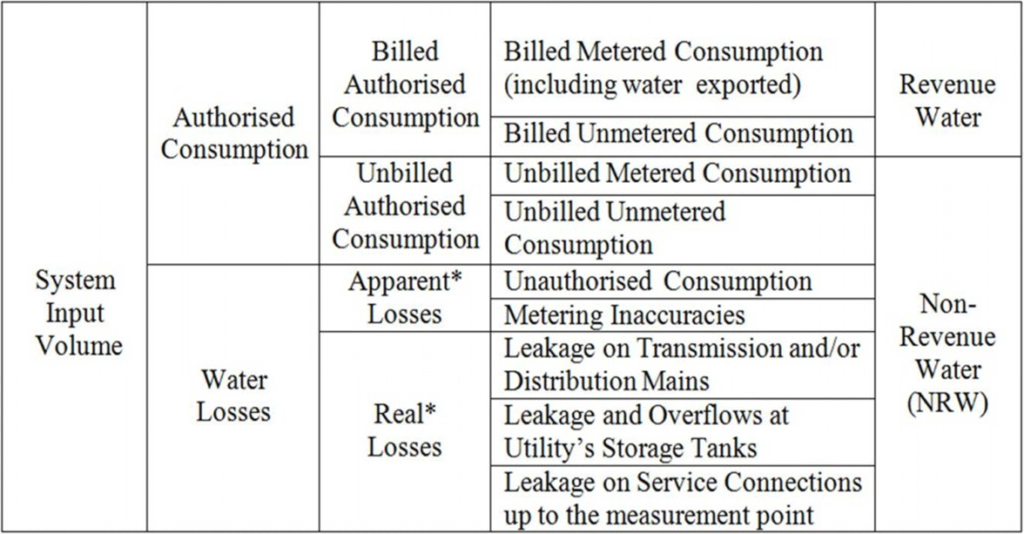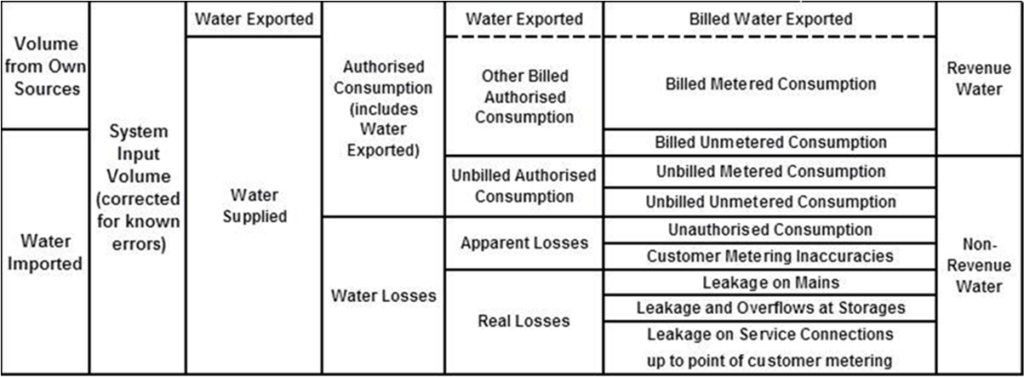IWA Best Practice Water Balance
Drawing on the best practice from many countries, the first IWA Water Loss Task Force, and the Performance Indicators Task Force, produced a standard approach for Water Balance calculations with definitions of all terms involved. The Water Balance first published in 2000 as shown below was a major step forward, and it is now used and recommended (with some additions) by consultants, Utilities, technical organisations, regulators, international funding agencies in an ever-increasing number of countries.

IWA Standard Water Balance as originally published in 2000* Parts of ASEAN region use ‘Commercial’ instead of ‘Apparent’, and ‘Physical’ instead of ‘Real’
Due to widely varying interpretations of the term Unaccounted-for Water (UFW) worldwide, it was recommended in 2000 that the term be discontinued, and UFW is now little used internationally. If the term UFW is used at all, it should be defined and calculated in the same way as Non-Revenue Water in the IWA Water Balance.
Numerous water balance software packages based on IWA Water Balance have been introduced and used at National, State and Utility level in countries in most regions of the World over the last 20 years. Some practical additions that can help to avoid errors and misunderstandings in applying and interpreting the IWA Water Balance are shown in the following version of the IWA Water Balance.
IWA Water Balance with Additions

This more detailed version of the Water Balance requires System Input Volume components (‘Volume from Own Sources’ and ‘Water Imported’) to be shown, then split into ‘Water Supplied’ and ‘Water Exported’. This assists auditing of water transfers and highlights the difference between System Input Volume (which includes Water Exported) and Water Supplied (which does not). Known errors in System Input Volume need to be corrected at the start of the Water Balance, otherwise they will appear as hidden positive or negative errors when the NRW, Apparent Losses and Real Losses are calculated.
Problems occur when %s of System Input Volume are used as a technical performance indicator for Non-Revenue Water or its components. The IWA 2000 Water Balance did not require the volume of Water Exported to be explicitly shown, so Utilities that export water can appear to have better NRW and Real Loss management performance (as % of System Input Volume) than Utilities that do not export any water. When Utilities which export water publish NRW%s, are they referring to % of System Input Volume or % of Water Supplied?
Another problem with the misuse of %s arises because some Utilities start the Water Balance at the source, and some at the output of Water Treatment Works. The IWA Water Balance definitions define System Input Volume as ‘the annual volume relating to that part of the Water Supply System to which the Water Balance relates’. It is recommended to carry out separate water balance calculations for raw water to treatment works output; transmission from treatment works output to individual distribution systems; and for each Water Balance supply Zone.
These are some of the reasons why comparisons using %s of System Input Volume are unreliable and misleading; see https://www.leakssuitelibrary.com/pros-abandon-percents-of-siv/ for further information on this topic.
The use of confidence limits in Water Balance calculations provides valuable insights into the reliability of the calculated components of NRW, and the priorities for action for improving the reliability of these calculations. As some users may lack confidence in using this technique, a ‘Concepts’ webpage on LEAKSSuite Library explaining this approach can be found at https://www.leakssuitelibrary.com/random-uncertainty-in-water-balance/.